indigenous
550 readers
1 users here now
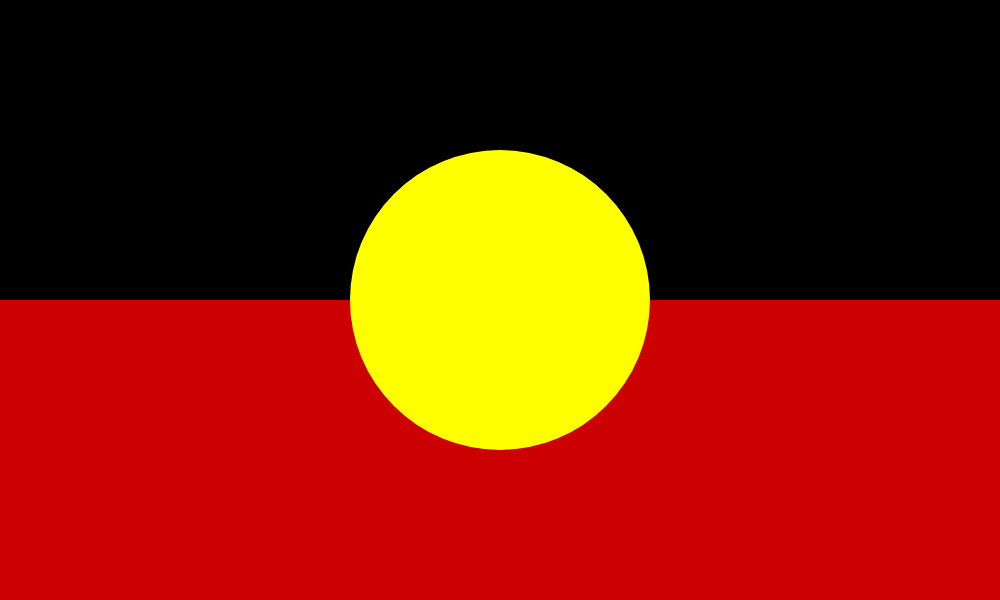
Welcome to c/indigenous, a socialist decolonial community for news and discussion concerning Indigenous peoples.
Please read the Hexbear Code of Conduct and remember...we're all comrades here.
Post memes, art, articles, questions, anything you'd like as long as it's about Indigenous peoples.

founded 1 year ago
MODERATORS
1
0
Secondarily there is also another urgent ask for a trailer for our permaculture specialists
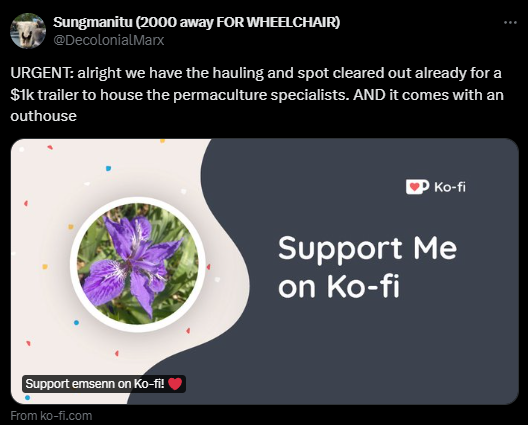
2
Here is a bit of an update post for CLN and the many things we have underway, our goals, and plans to accomplish them though it is in slide form, just trying to condense larger documents that are being finalized
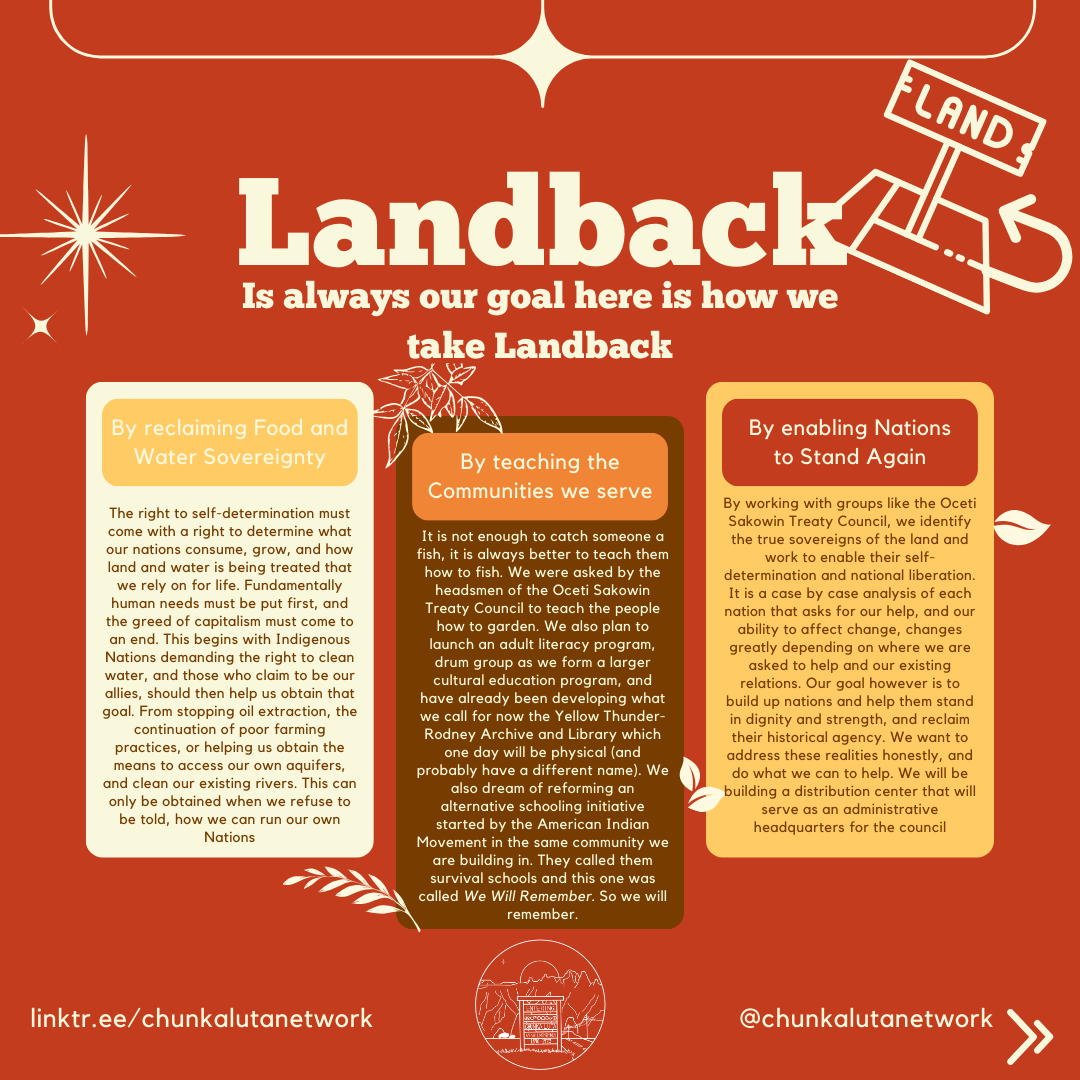
Our main goal is to offer an actual Marxist-Leninist position on landback, that is easier to articulate than the current offerings by many groups that all boil to Indigenous self determination and ending of global colonial exploitation
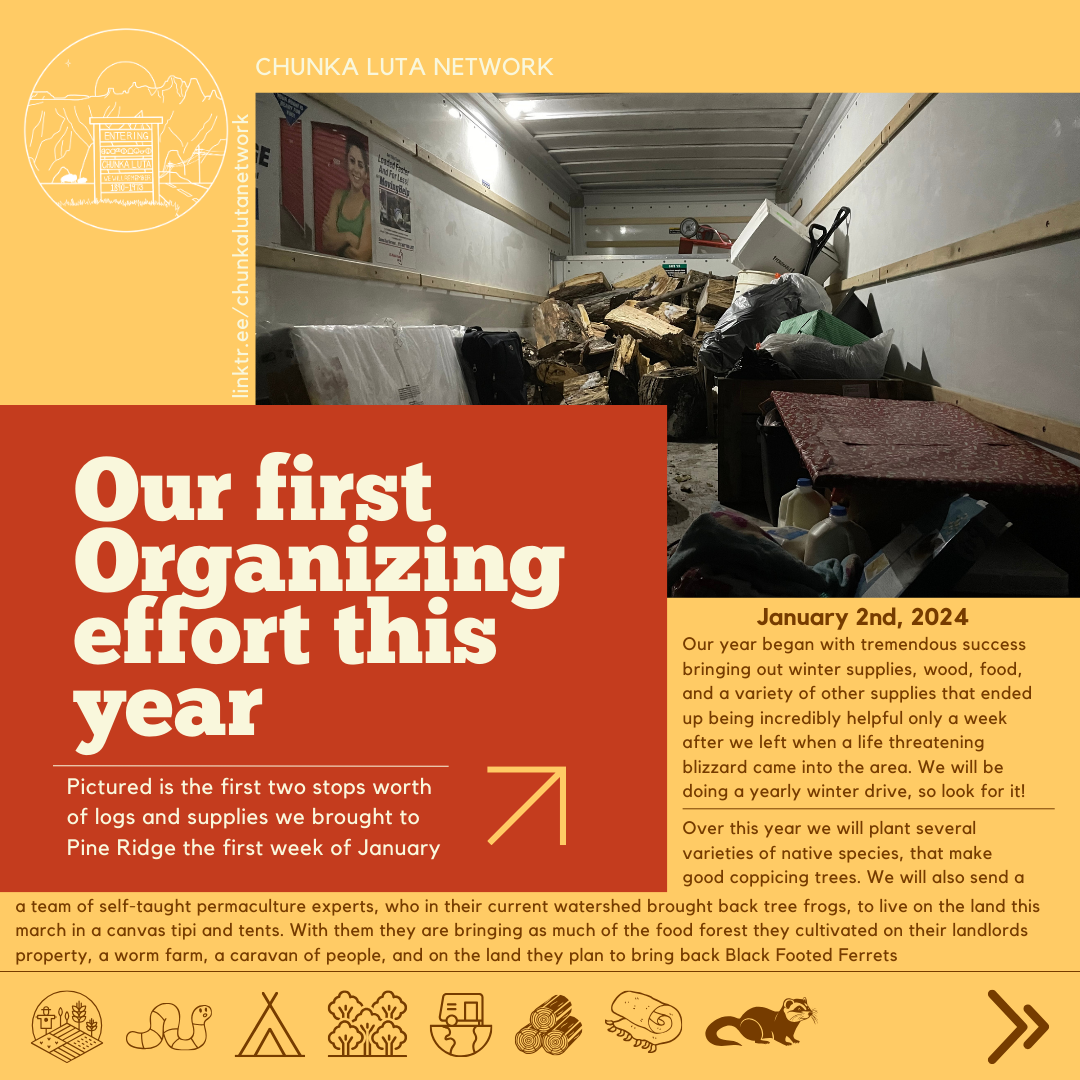
We are a organization based in demcent, and scientific socialism. There are many like minded groups and individuals working towards the collective liberation of the land, and life from the contradictions of colonialism and Imperialism.

Our goal is to go beyond cheerleading, and instead enable people to lead. This was my largest criticism of The Red Nations "The Red Deal" and you can hear more of my in depth thoughts starting Season 8 on the Marx Madness podcast. I offer 40 hours of reading you the book word for word and offering my criticism as openly as I could.
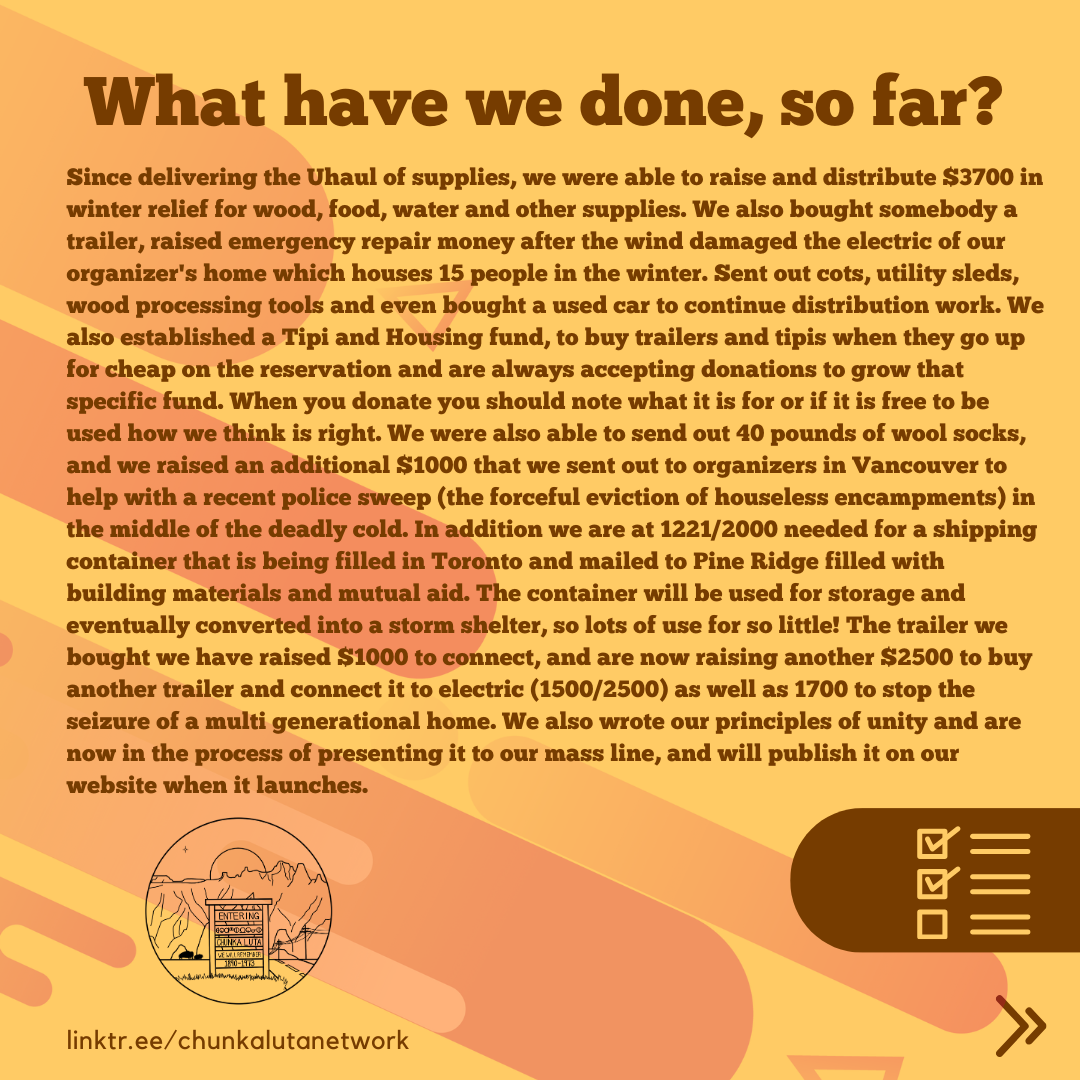
The specific house at risk of seizure is my dad's who is a Union member, and my brother who has a different dad but live with my dad also live there. They have 3 kids in the house and he's a native with a record in a bordertown so the financial situation has been hard after some medical issues occurred, some legal issues, and then some neighbor issues on top of the city raising water rates and their bill being $400 this month so they could really use this help and can even pay people back if you want after they get their tax return which has been delayed for one reason or another due to paper work taking a while to get to them.
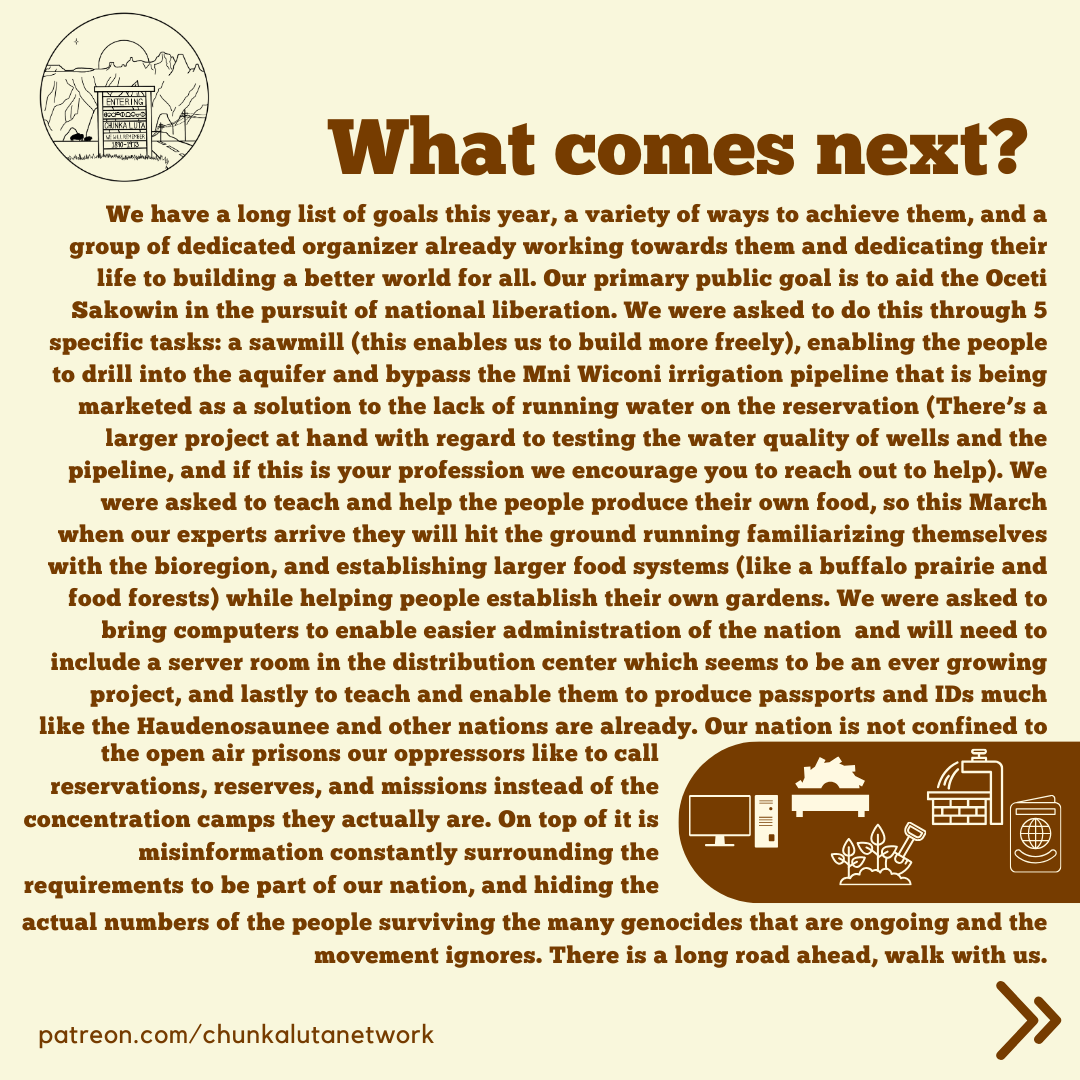
Our biggest goal is self determination through dual power systems during a war of position. Through this preparation we demonstrate an ability to build, plan, and lead. This we think is an important ability for any cadre, and we do this through building up cadres in different regions across the world.

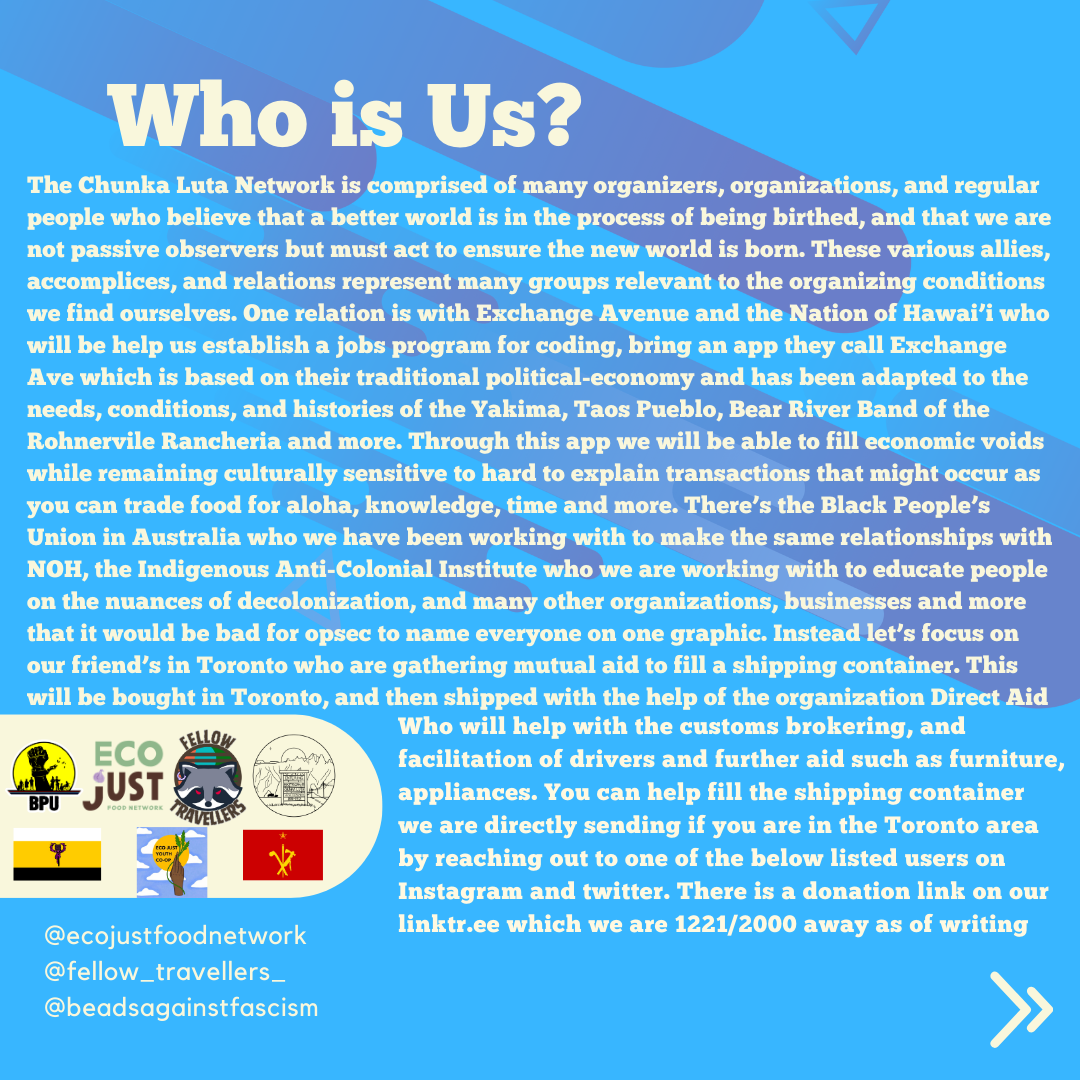
One of these groups is in Toronto and is working to send the shipping container we are raising money for to pay back the organizers who fronted the last portions to assure we got the container in time for the deadline.

We are of course most excited about the future so I encourage people to keep their eye out for the website where we will be uploading public viewable financial information, there we will also replace the patreon and liberapay but for now you can find links to those https://linktr.ee/chunkalutanetwork as well as various GFM links to efforts mentioned in the updates
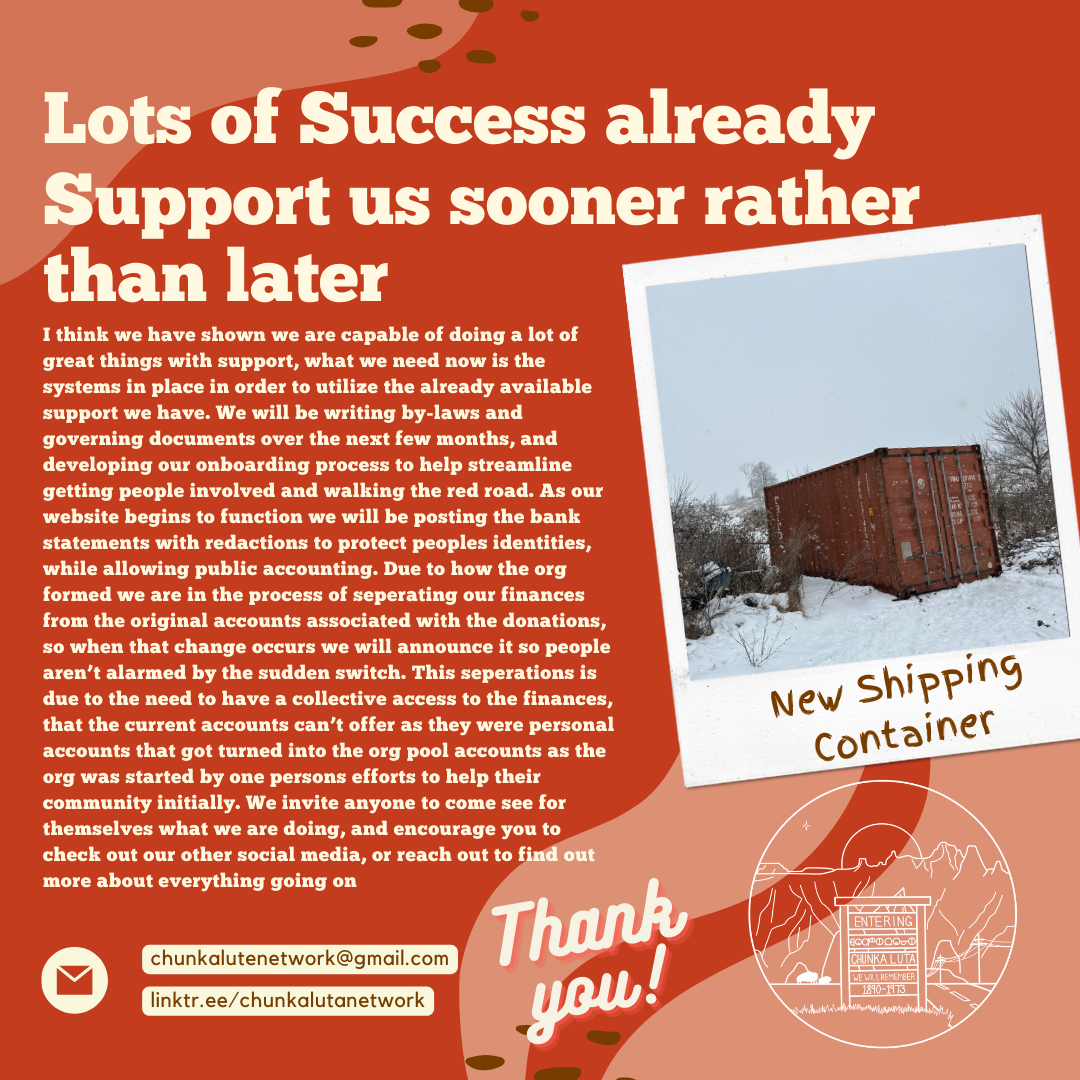
We are doing great things and I think everyone should check out our friends at the Nation of Hawai'i, Black Peoples Union in Australia, and more
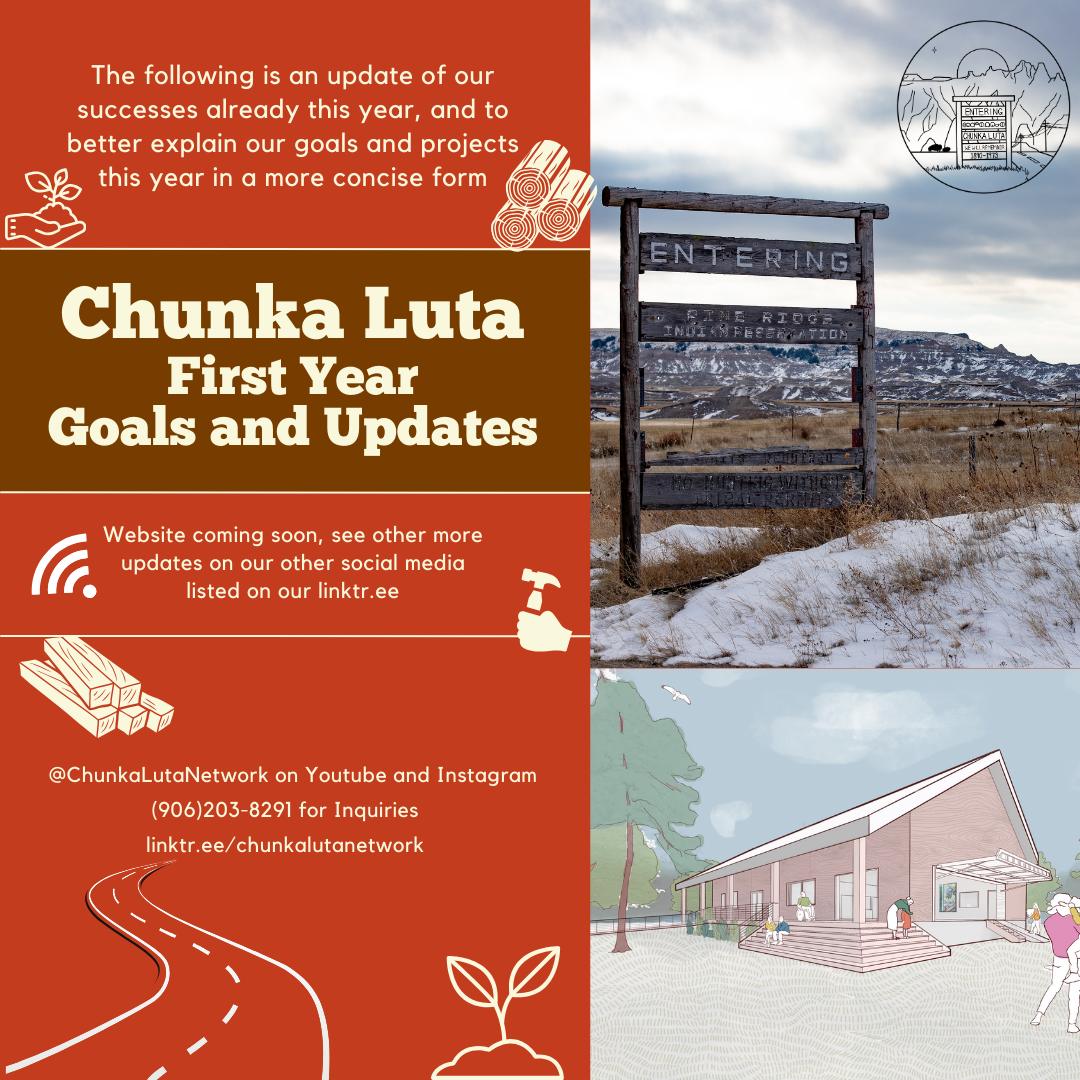
3
Here is a dossier we have been developing for the last year, that's gone through a review by the communities we serve, as well as our organizers, and now it is time for our public review: That is why I am posting this here


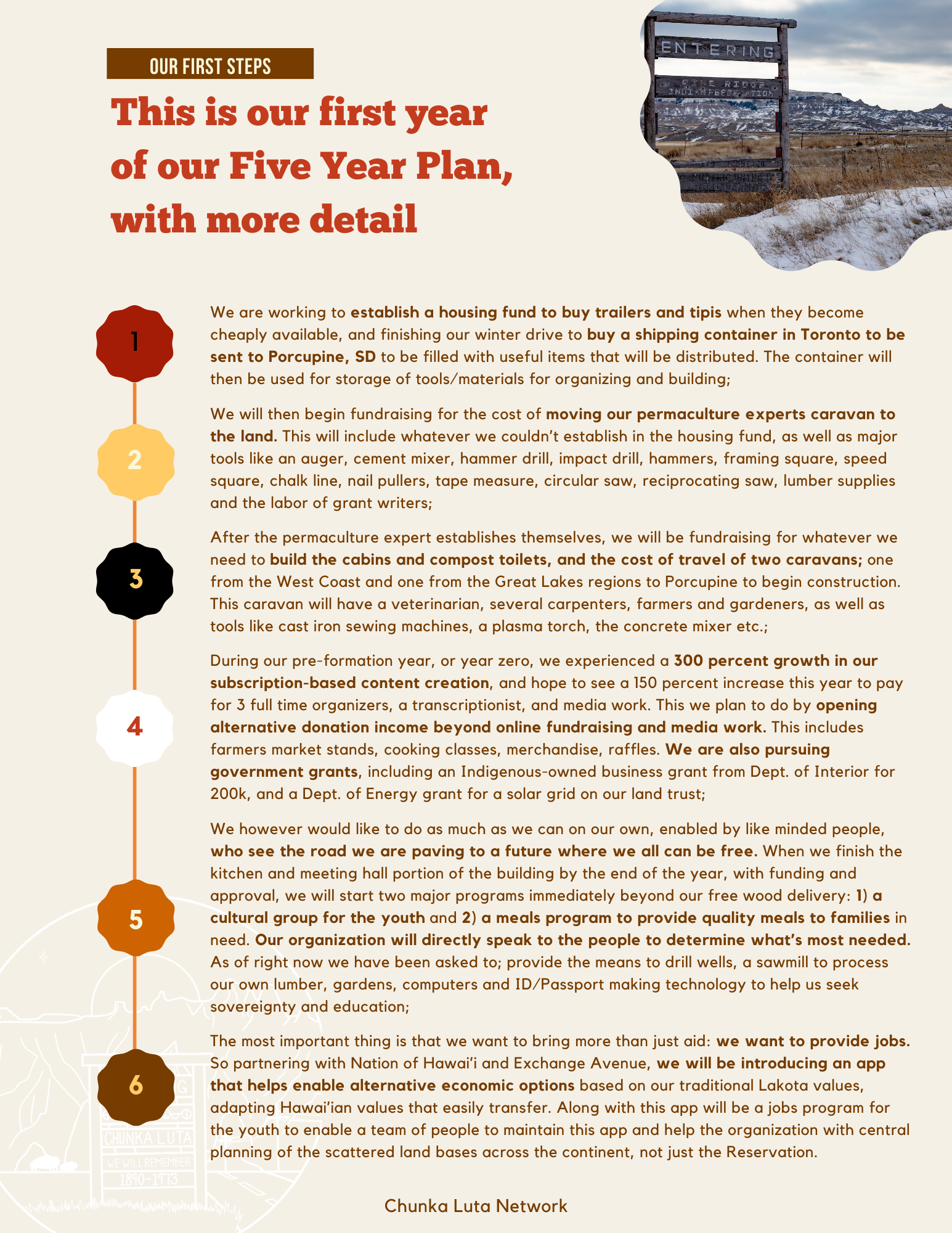
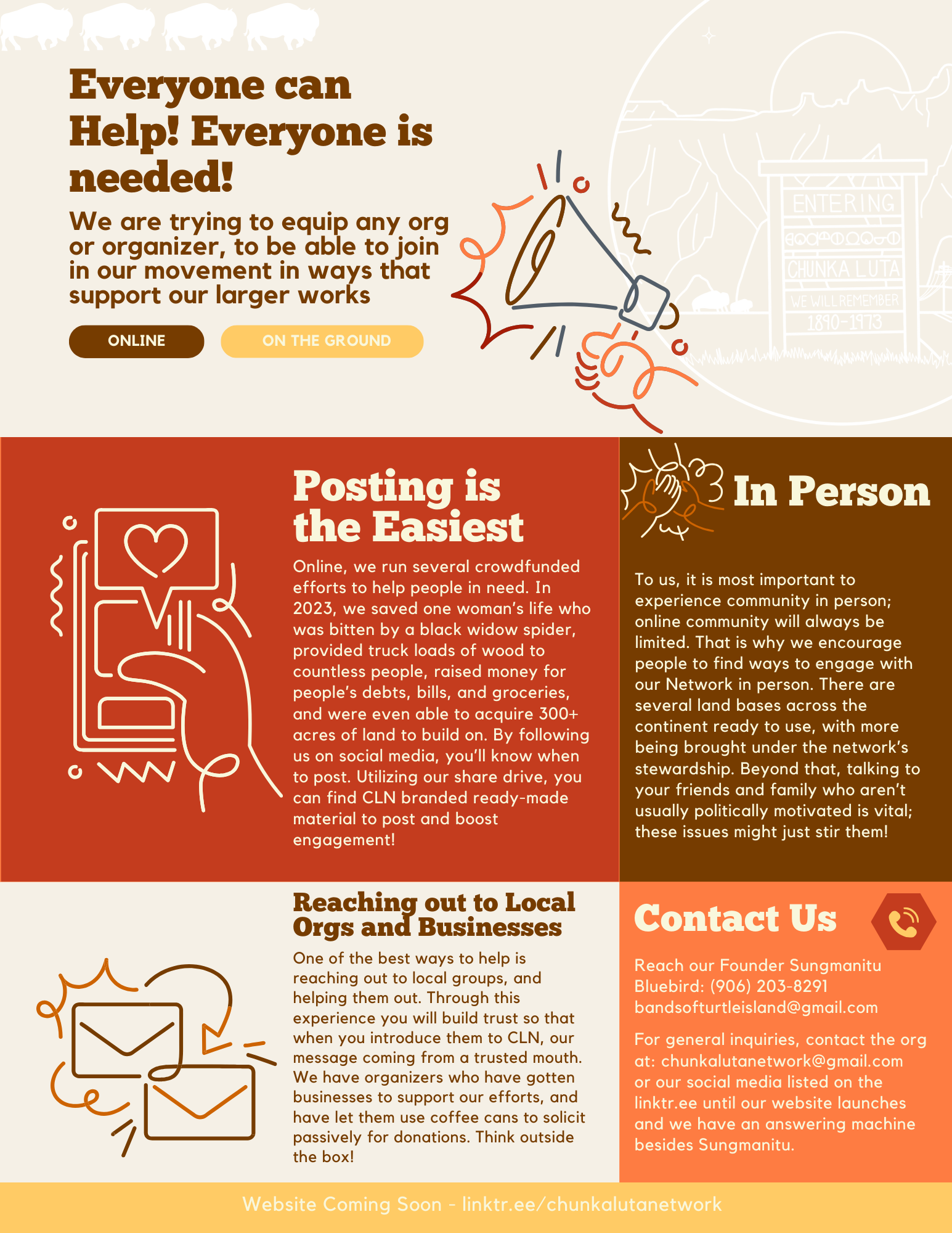




Along with videos in development, a further public five year plan, and several theoretical pieces of our unique contribution to the contemporary theoretical landscape, we have joined with the budding Indigenous Anti-Colonial Institute that you can find the first episode on youtube and spotify idk about anything else yet. Already this year we brought a 20' Uhaul full of wood, winter gear, hygiene materials, gardening materials, and whatever else we could fit like a child's bed. We also raised the money to purchase a new home on the land, are in the process of sending 40 lbs of socks to the Rez, raised 500/2500 of the storage container costs we need by the end of the month, are finalizing our Principles of Unity, facilitating 4 nation to nation treaties, are halfway to our goal of 2k a month to support our organizers survival with 500 stipends, and have raised several thousand dollars in the last day to keep folks alive during this deadly weather

I am attempting to bypass the character limit via the photos so forgive me. However we are on a great trajectory and the momentum is undeniable. On https://linktr.ee/chunkalutanetwork you can see several fundraising efforts we are doing and see our liberpay and patreon options to become monthly sustainers of our efforts, our website will be launching later this year, and really get involved. Help out. Theres so many ways and I think we are proving ourselves very capable at organizing great things, and you will see us move mountains this year. So follow our various social medias, and Im seriously going to try to engage here this year. I just hate social media in general and this doesnt give me a bright notification on my phone. We also highly encourage sharing and in our library (once I update the materials available) stuff like this will be readily accessible for your posting pleasure

4
0
https://youtu.be/4j48owNmquc?feature=shared here's a great video featuring more of the Swallow family, new media from the winter drive coming soon check out our linktr.ee/chunkalutanetwork for ways to support our work and organizing efforts.
yewtu.be
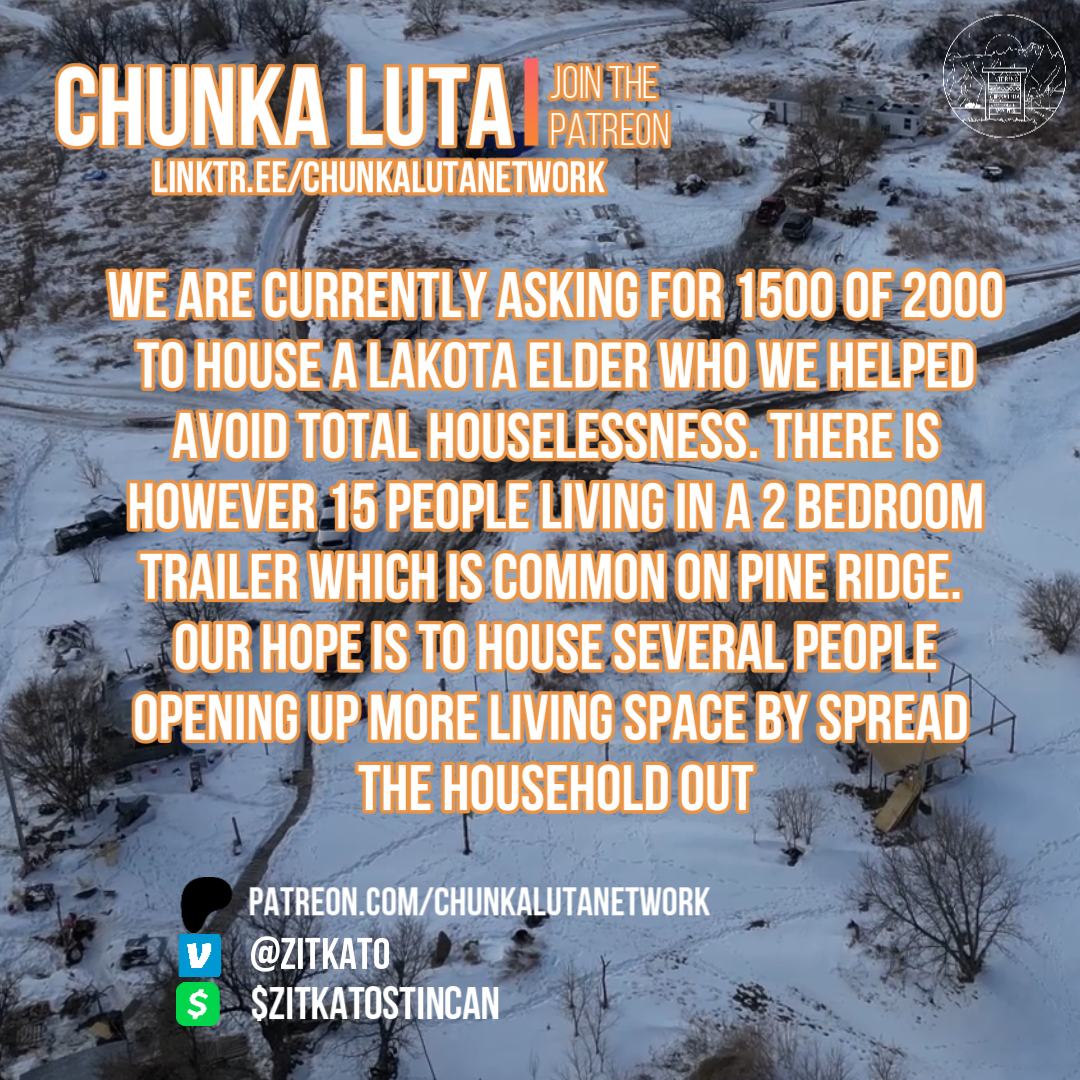
5
0
On Tuesday, Energy Fuels Resources, the company that owns a uranium mine near the South Rim of the Grand Canyon, began hauling ore to a mill in southern Utah.
In a statement, the company said the shipments are safe, have low levels of radiation and have been permitted by state and federal regulators.
But the transport route includes a large swath of the Navajo Nation, which opposes the mine and has outlawed uranium hauling through its lands.
Navajo President Buu Nygren quickly sent out Navajo police in an effort to turn the trucks back, but the shipments eventually passed through the reservation on highways regulated by state agencies.
The president has vowed to stop any future uranium hauling and spoke with KNAU’s Ryan Heinsius about the tribe’s response.
6
0
7
- Sustainable farming, mercury-free fishing and circular trade are among the strategies Amazon Indigenous peoples have been developing to survive in one of the most hostile states for Indigenous people in Brazil.
- Territorial and Environmental Management Plans (PGTAs) are one of the Indigenous-led tools for communities to create strategies to manage their natural resources and provide income for families in their territories.
- For long-term survival, these sustainable initiatives require investments, but previous experience has shown that a top-down approach is often counterproductive. But even as they achieve successes with various initiatives, monoculture agribusiness, illegal mining and land grabbing continue to threaten their livelihoods.
NOVO PARAÍSO, Brazil – Under the scorching sun and blue sky, the freshly weeded cassava fields offer no shade to hide in this piece of the Amazon Rainforest. It’s winter, time for planting. As the days go by, most in excess of 30° Celsius (86° Fahrenheit), heavy rains to come will make the seeds sprout.
The cassava crops through which Maria Loreta Pascoal now walks are the livelihood of the Indigenous community of Novo Paraíso, where she has been the tuxaua, or chief, since being elected in late 2022. “All of us in the community are farmers,” Pascoal tells Mongabay. “This is how we cultivate our subsistence.”
Life in Novo Paraíso, located in the Manoá-Pium Indigenous Territory in the Brazilian state of Roraima, relies heavily on the production and trade of cassava flour. Some nine months from today, the cassava plants that now barely scrape the tuxaua’s heels will be ready for harvesting and handling.
Demarcated and homologated, or officially recognized by presidential decree, in 1982, Manoá-Pium covers an area of less than 44,000 hectares (109,000 acres). It’s home to seven communities with a combined population of more than 3,900 people, all of whom depend on family farming.
On the hour-long drive from Boa Vista, capital of Roraima, to Novo Paraíso, changes in the landscape are striking. Most of the preserved areas along the road are covered by the lavrado, a savanna-like vegetation. Pascoal’s community, however, is an exception: it’s coated in tall, thick, dark-green trees — what you’d imagine on hearing the word “rainforest.”
However, the most distinct variations are perceptible when crossing monocultures. Besides the visible contrast between the homogenous farms and the vibrant forest, differences in the temperature and air quality are palpable: the air is dry and the heat feels arid on the skin when driving alongside the monocultures.
Like other Indigenous lands in Roraima, Manoá-Piuam was demarcated in what’s known in the state as an island format. Rather than being composed of a large, contiguous swath of territory, these lands are small and encompass only a few communities, separated from one another and surrounded by monoculture plantations.
8
18
Māori leaders propose protecting whales in international waters at UN general assembly
(www.teaonews.co.nz)
King Tūheitia, together with other leaders of Aotearoa and the Pacific, have supported a resolution for the adoption of the whale as ocean ambassador to the United Nations.
This resolution aims to garner support for a global agreement that protects the legal personhood of whales in international waters.
Dr Ralph Chami of Blue Green Future, a prominent figure working alongside Indigenous founders of the Hinemoana Halo Ocean Initiative, presented the proposal to the UN. This initiative also seeks to implement indigenous customary protections across whale migration routes, ensuring the preservation of critical feeding and breeding grounds.
Lisa Tumahai (Ngāi Tahu), one of the leaders supporting the resolution, expressed the significance of this collective effort by Māori tribes. “For the first time, our tribes have formed a collective to work to implement Indigenous customary protections across whale migration routes between critical feeding and breeding grounds,” she said.
The Hinemoana Halo Ocean Fund (H20 Fund), co-chaired by Tumahai, plays a crucial role in this endeavour. The fund aims to raise $100 million through a blue bond for indigenous-led blue habitat restoration and trophic rewilding projects. This ambitious plan seeks to recover and protect whale populations across the Pacific Rim, with the fund serving as the Pacific’s first Indigenous Peoples and Local Communities (IPLC)-led climate finance mechanism.
The work of Blue Green Future’s Chami and the Indigenous tribes in Aotearoa and the Pacific aligns with the growing scientific recognition of whales’ vital role in addressing climate change and ocean biodiversity loss.
Acknowledging the tohorā
Conservation International Aotearoa vice-president Mere Takoko emphasised the importance of Chami’s collaboration with Indigenous tribes, stating, “Dr Chami’s work with our Indigenous tribes in Aotearoa and the Pacific adds to the growing scientific acknowledgment of the role that our relations, the tohorā (whales), play in addressing the twin challenges of climate change and ocean biodiversity loss.”
H20 Fund co-chair Aperahama Edwards (Ngāti Wai) expressed his tribe’s commitment to restoring the authority of Indigenous tribes over their oceans to support this global effort. “It is important that indigenous peoples from across the Pacific come together to rewild our oceans and restore blue habitats to help stabilise our communities on their lands and create long-term climate resilience,” he said.
Indigenous representatives have pledged to collaborate in establishing the world’s largest Indigenous marine protected area network, covering an expansive 2,200,000 km² area through the Hinemoana Halo Ocean Initiative.
This network will operate under a customary protection framework, channelling more resources into whale conservation and implementing seasonal protections along whale migratory routes or “blue” corridors. The comprehensive plan for this initiative will be unveiled at the 2024 UN Ocean’s Decade Conference in Barcelona, Spain.
The Māori leaders’ resolution to adopt the whale as the ocean ambassador and seek global support for protecting the legal personhood of whales in international waters marks a significant step towards safeguarding these majestic creatures and preserving the health of oceans.
As the international community gathers at the United Nations General Assembly, the hope is this resolution will garner widespread support and pave the way for a global agreement that recognises the intrinsic value and rights of whales in shared waters.
9
7
Indigenous supporters march to defend Guatemala's president-elect amid vote fraud allegations
(abcnews.go.com)
GUATEMALA CITY -- Thousands of indigenous supporters protested in Guatemala City on Monday to defend Guatemala’s president-elect as government prosecutors seek to ban his political party.
Many of the protesters carried banners or chanted slogans demanding the resignation of government officials who have sought to prosecute Bernardo Arévalo and ban his Seed Movement party.
Aleisar Arana, a leader of the Xinca ethnic group, called the prosecutions an attempt at a “coup.”
“The coup that the prosecution is leading must be stopped,” Arana said. Protesters threatened to keep demonstrating until the efforts against Arévalo are stopped.
Arévalo won the Aug. 20 presidential runoff in a landslide, but prosecutors have continued pursuing multiple investigations related to the registration of Arévalo’s Seed Movement party, and alleged fraud in the election. International observers have said that is not supported by evidence.
Arévalo announced plans last week to call Guatemalans into the streets to protest efforts to derail his presidency before he can take office, he said Friday in an interview with The Associated Press.
A coalition of academic and rights groups issued a statement Monday saying that international pressure should be stepped up to ensure Guatemala respects the results of the elections.
Arévalo said he has tried his own legal maneuvers to stop those who want to keep him from power, but now it’s necessary for the people to come out to the streets to support him. He said he wants to see businesspeople, farmers, Indigenous groups, and workers all come out.
Arévalo, a progressive lawmaker and academic, shocked Guatemala by making it into the runoff in which he beat former first lady Sandra Torres by more than 20 points.
The attorney general’s office has said it is only following the law, but has come under intense criticism within Guatemala and abroad for what appears to be a brazen attempt to keep Arévalo from coming to power, or to weaken him.
Arévalo acknowledges the task ahead won't be easy.
“Hundreds of years of marginalization, discrimination, the accumulated problems of 30 years of corrupt assault on power aren’t just going to disappear because we’re here,” he said. “But if we can start to change, to make the people feel that there are authorities who respond to them.”
This week, agents from the Attorney General’s Office opened boxes of votes and photographed their contents in an unprecedented violation of Guatemala’s electoral law.
Arévalo has called for Attorney General Consuelo Porras’ resignation and said he would temporarily suspend the process of transition from outgoing President Alejandro Giammattei.
10
48
-About 20,000 people in Brisbane attended a rally in support of the ‘Voice to Parliament’ proposal, with similar events also held across other Australian cities
-The proposal, which aims to enshrine indigenous people in Australia’s constitution, appears on track for defeat, according to a recent poll
Thousands rallied in Australia on Sunday to support recognising the country’s indigenous people in the constitution, a proposal that is struggling ahead of a referendum next month.
If approved on October 14, the measure would enshrine indigenous people in the constitution and set up an advisory body to give Aboriginal and Torres Strait Islander people input on policies that affect them.
Indigenous Australians, who account for 3.8 per cent of the population, face disadvantages including discrimination, poor health and education outcomes and high incarceration rates.
But the “Voice to Parliament” proposal appeared on track for defeat, a poll showed last week, the fifth monthly survey in a row to find voters against the change.
Yes23, the group behind “Walk for Yes” events, said around 20,000 people attended in Brisbane, Australia’s third-biggest city.
In Melbourne, more than 10,000 supporters marched through the streets, some with banners reading: “You’re the voice, vote yes”. Thousands more gathered in Canberra, Perth, Brisbane, Darwin, Hobart and Alice Springs.
Many attendees wore T-shirts and held placards emblazoned “Vote Yes!”, Australian Broadcasting Corp (ABC) footage showed.
“I think we need a voice in parliament and I think it’s about time,” said Laurel Johnson, a 58-year-old retired indigenous community services worker who joined hundreds of people at the Sydney rally, many seeking shade during a spring heatwave.
Cameron Lum, a 34-year-old supporter of the Voice proposal, said he joined the Sydney rally to support “long overdue change in this country”.
“I think it opens doors to massive policy change led by first nations people,” he said.
To change the constitution, the referendum, backed by Prime Minister Anthony Albanese’s Labor government, would require a national majority in favour and majorities in at least four of Australia’s six states.
Most indigenous people favour the referendum, but some, like prominent No campaigner Warren Mundine, say it is a distraction from achieving practical and positive outcomes and would not fully resolve the issues affecting them.
“If we can do just three things – accountability, jobs and education – then we’ll resolve most of the problems we’ve got,” Mundine told ABC.
To pass, the referendum needs majority support across Australia, but also a majority in at least four of the six states.
Voting is compulsory, with non-voters who do not have a valid reason liable to a fine of A$20 (US$13).
Voters will be asked: “A Proposed Law: to alter the Constitution to recognise the First Peoples of Australia by establishing an Aboriginal and Torres Strait Islander Voice. Do you approve this proposed alteration?”.
Since Australian independence in 1901, only eight of 44 proposals for constitutional change have been approved.
11
In the west the rivers were both important boundaries and means of transportation. Watersheds defined the boundaries of most nations.
The pre-contact map of Canada was very different than the description given by the European nations. They regarded it as empty land with no Christian inhabitants and, therefore, fair game for conquest. Or, as Voltaire referred to it, a “few acres of snow.”
But Turtle Island was an ordered and civilized group of nations that had created their boundaries based on negotiations using the rivers and watersheds.
The boundary between the Haudenosaunee and the Algonquin nations was the Saint Lawrence River, which no doubt had a different name.
In the west the rivers were both important boundaries and means of transportation. Watersheds defined the boundaries of most nations.
The Churchill watershed is the home to the Woodland Cree. The Woodland Cree live along the Churchill River from northern Manitoba to north central Saskatchewan and as far north as Reindeer Lake and as far south as Montreal Lake. The entire area is accessible by waterways that flow into the Churchill River.
The Cree name for the Churchill is Missinippi, which translates as “big water” since it is a chain of lakes rather than a river in the traditional sense. Big River in Cree translates as “mista sipi” which most likely was the Cree name for the Mississippi River.
In Indian country, the Red Deer River or Elk River extends from the Rocky Mountains to the forks east of Prince Albert. It’s a matter of perspective. The early fur traders thought that the Saskatchewan River was one river with a south and north branch.
They were travelling from the east, so they had that perspective. The First Nations perspective was more realistic. The Elk River comes from the elk pastures in the foothills and all the other rivers in southern Alberta join it, so it remains the Elk River all the way to the forks.
The Elk River also forms the boundary between the Blackfoot and Cree territory. This boundary was negotiated in the treaty between the two nations at the Bear Hills in what is now Alberta. The Blackfoot territory includes rivers that flow into the Red Deer River, including parts that are in the United States.
The Blackfoot Nation extends into the United States and is recognized by the Blackfoot reservation in Montana.
The northern boundary of Cree country was also determined by a treaty. In the early 1700s, the Cree and Dene met at a camping place on the Peace River west of Lake Athabasca. Today the area is called Peace Point.
The two nations agreed to live in peace and the Peace River would be the boundary. The name Peace River is used by both nations and the treaty gave the river its name. This gave the Cree access further inland and eventually they settled as far west as Moberly Lake in what is now British Columbia.
The watershed of the Mackenzie River forms the land base for the Dene Nation. This vast watershed goes as Far East as Wollaston Lake in Saskatchewan to its northern terminus at the Arctic Ocean. The Dene in northwest Saskatchewan enter the Mackenzie watershed via the Clearwater River.
In Saskatchewan and Alberta, the Saskatchewan River played an important role. The people along the river were known as the upstream people, or the river Cree.
This area included the confluence of the Battle River and the Saskatchewan River known as Battleford, since it was relatively easy to ford the Saskatchewan River at that location. The western end was Rocky Mountain House, which was the end of the navigable part of the river.
During the negotiations for Treaty No. 6, Chief Red Pheasant was the leading chief of the river Cree.
Canada was not an empty land before European contact. We had political boundaries, commerce and alliances. We are people of this land, and our roots go deep. This is borne out by the relationship we have with the waterways and landmarks.
We weren’t discovered and the European explorers didn’t go where nobody had gone before. In fact, they were guided along long-existing canoe roots that connected the land and formed an inland trading empire.
Our people created the infrastructure for Canada; all the newcomers had to do was adopt it.
13
11
Māori researchers join global indigenous experts tackling climate change, food security
(www.teaonews.co.nz)
Two Waikato University researchers are joining an international collaboration of indigenous experts looking at the urgent challenges of climate change and food security.
Associate Professor Maui Hudson (Te Whakatōhea, Ngāruahine, and Te Māhurehure) and Dr Haki Tuaupiki (Waikato, Ngāti Tūwharetoa) have been “shoulder-tapped” as investigators within a newly launched Center for Braiding Indigenous Knowledges and Science (CBIKS) based at the University of Massachusetts Amherst in the United States.
The centre aims to connect indigenous knowledge with mainstream western sciences to create new ways to address “some of the most pressing issues of our time,” the University of Waikato said.
“Climate change, including impacts on ecosystems; the threat to irreplaceable archaeological sites, sacred places, and cultural heritage; and the issues around changing food systems, all of which disproportionately affect Indigenous communities.”
The research team brings together the world’s leading indigenous natural, environmental and social scientists, representing Native American, First Nations, Métis, Native Hawaiian, Alaska Native, Māori and Indigenous Australian peoples.
Community-based research and place-based studies will be done in partnership with indigenous communities in eight international hubs, with the Waikato academics part of an Aotearoa contingent within the Pacific hub.
Full Article
‘An important step’ “Combining Indigenous and mainstream Western sciences to address complex global problems is an important step towards more equitable partnerships with indigenous communities, the co-production of knowledge, and the development of place-based, community-centred solutions,” Hudson said.
He is the director of Waikato University’s Te Kotahi Research Institute, which supports research and capacity-building initiatives that support the aspirations of iwi, Māori and indigenous communities.
Hudson will co-lead the indigenous data sovereignty working group.
“This work is primarily about developing approaches and processes that enable the hubs and different studies to share traditional knowledge in the context of the different research activities while protecting that knowledge and ensuring it is not misappropriated.”
Tuaupiki said the indigenous knowledge will be used in a culturally safe way.
“Indigenous ancestral knowledge, with thousands of years of articulation and practice, has always been important and extremely valuable, never more so than now,” said Tuaupiki, who is a senior lecturer at Te Pua Wānanga ki te Ao - Faculty of Māori and Indigenous Studies.
“This international collaboration of Indigenous leaders and experts will see us utilise Indigenous ancestral wisdom in an ethical and culturally grounded way with the best of Western science to find solutions to climate change for our communities and the world.”
Tuaupiki is co-director of the Pacific hub, alongside Kelley Uyeoka from Huliauapa’a in Hawai’i, a cultural resource management non-profit organisation.
“Our work will focus on food sovereignty, traditional food restoration, wāhi kupuna (ancestral spaces) stewardship, and voyaging and navigation responses to climate change,” he said.
The CBIKS website says its research is fully community-based, developed from indigenous community priorities and conducted in full partnership with indigenous community partners across the United States and internationally, including 57 indigenous communities.
“CBIKS is about recognizing that Indigenous knowledge systems carry tremendous information and value, and it’s shortsighted to think that current research practices founded on Western knowledge systems are the only or ‘right’ approach,” said CBIKS director Professor Sonya Atalay.
14
45
Indigenous Leaders and Allies Arrested at White House Rally in Support of Clemency for Leonard Peltier
(www.counterpunch.org)
The following is a press release from the NDN Collective.
WASHINGTON – Thirty-five Indigenous leaders and allies were arrested by U.S. Park Police outside the White House Tuesday afternoon as they joined hundreds of activists and allies in urging President Joe Biden to grant clemency for imprisoned Native American activist Leonard Peltier. Held on Peltier’s 79th birthday, many activists traveled to the D.C. rally in a caravan that started on the Pine Ridge Reservation in South Dakota.
Fawn Sharp, president of the National Congress of American Indians (NCAI); Dallas Goldtooth, organizer and actor; Nick Tilsen, president and CEO of NDN Collective; and Paul O’Brien, executive director of Amnesty International USA were among the 35 arrested at the White House by U.S. Park Police after U.S. Secret Service cleared activists from Pennsylvania Avenue. The rally was led by NDN Collective and Amnesty International USA.
Imprisoned for nearly 50 years, Leonard Peltier is serving two life sentences for his alleged role in the deaths of two FBI agents during a shootout on the Pine Ridge Indian reservation in South Dakota in 1975. His imprisonment is widely recognized as the product of a flawed prosecution, trial, and conviction by international human rights organizations, Tribal leaders, many members of Congress, and even the former US Attorney whose office handled the prosecution and appeal.
At the rally, a statement from Leonard Peltier was read by Holly Cook Macarro of NDN Collective, including the following quote:
“Year after year, I have encouraged you to live as spirit warriors. Even while in here, I can envision what is real and far beyond these walls. I have seen a reawakening of an ancient Native pride that does my heart good. I know that the spirit warriors coming up behind me have the heart and soul to fight racism and oppression, and to fight the greed that is poisoning our lands, waters, and people. I know there are those who stand with me, who work around the clock for my freedom. I have been blessed to have such friends. We are still here and you give me hope.”
Read Leonard Peltier’s full letter here.
https://ndncollective.org/i-am-still-here-leonard-peltiers-letter-to-supporters/
The following speakers addressed crowds at today’s rally sharing the below remarks. Please feel free to use these in your reporting:
Dallas Goldtooth, Organizer, Actor, and MC of the rally: “Leonard is our grandfather and our uncle. He has been locked up my entire life. He’s an elder now and deserves to be among his people and his community. He deserves to be back on the land.”
Nick Tilsen, Oglala Lakota, President and CEO of NDN Collective: “We come together here to remind the United States that Leonard Peltier is the longest-incarcerated political prisoner in the history of the United States. It is a reminder of how they treat the Indigenous people of this land. And so I ask all of us to continue, and those of you who are at home, we cannot let his fight for freedom go quietly. It’s time – 48 years is long enough.”
Fawn Sharp, President of the National Congress of American Indians (NCAI): “79 years ago on this very day, a warrior was born. For 79 years, this warrior, our relative, our elder, Leonard Peltier, walked these lands with purpose, with a fire, with a special calling on his life, and he has galvanized a movement for justice in the United States. Release Leonard!”
Suzan Shown Harjo: “Each and every person in this country deserves a fair trial and rectification if the institutions meant to protect them do not do so. Mr. President, I urge you to grant clemency to Leonard Peltier. I am optimistic that you will find it in your heart to return Mr. Peltier to his Turtle Mountain homeland.”
Kevin Sharp, former federal judge & Peltier’s pro bono attorney: “As a lawyer and a former federal judge who had tried dozens and dozens of criminal cases, it didn’t take long to become shocked at what I was seeing with Leonard’s case. The level of constitutional violation and misconduct by the United States government, including by federal law enforcement and a federal prosecutor was abundantly high.”
Paul O’Brien, Executive Director of Amnesty International USA: “We have justice on our side. We have history on our side. We have right on our side. And I want you to know, Leonard, you have a quarter of a million Amnesty members on your side and we’re not going to let this go.”
Nick Estes, Lower Brule Sioux, Prof.- Univ. of MN, Red Nation: “A greater humanity, a greater power, one that is guided by morals and principles that come from the land itself – that’s what we recognize with the freedom of Leonard Peltier. It’s time for President Biden to take action to free our relative.”
The rally builds upon the decades of advocacy around Leonard Peltier’s case led by Native American activists for whom Peltier’s continued incarceration is a symbol of historical mistreatment and whose release is an opportunity for President Biden to recognize the injustice behind his conviction and continued incarceration.
Key figures involved in Mr. Peltier’s prosecution have stepped forward over the years to urge his release – former Judge Gerald Heaney, who presided over Mr. Peltier’s 1986 appeal in the Eighth Circuit, called for his release in 1991 and again in 2000. Former U.S. Attorney James Reynolds, whose office handled the prosecution and appeal of Peltier’s case, has called on President Biden to commute the remainder of his sentence. Retired FBI Special Agent Coleen Rowley wrote a letter to President Biden on December 3, 2022, in support of clemency for Peltier. The United Nations Working Group on Arbitrary Detention specifically noted the anti-Indigenous bias surrounding Peltier’s detention, stating simply that he “continues to be detained because he is Native American.”
15
19
As federal agencies prepare to deregulate transgenic chestnuts, Indigenous nations are asserting their rights to access and care for them.
This story was co-published with Native News Online
When Neil Patterson Jr. was about 7 or 8 years old, he saw a painting called “Gathering Chestnuts,” by Tonawanda Seneca artist Ernest Smith. Patterson didn’t realize that the painting showed a grove of American chestnuts, a tree that had been all but extinct since his great-grandparents’ time. Instead, what struck Patterson was the family in the foreground: As a man throws a wooden club to knock chestnuts from the branches above, a child shells the nuts and a woman gathers them in a basket. Even the dog seems engrossed in the process, watching with head cocked as the club sails through the air.
Patterson grew up on the Tuscarora Nation Reservation just south of Lake Ontario near Niagara Falls. The painting reminded him of his elders teaching him to harvest black walnuts and hickories.
“I think, for me, it wasn’t about the tree, it was about a way of life,” said Patterson, who today is in his 40s, with silver-flecked dark hair and kids of his own. He sounded wistful.
The American chestnut tree, or číhtkęr in Tuscarora, once grew across what is currently the eastern United States, from Mississippi to Georgia, and into southeastern Canada. The beloved and ecologically important species was harvested by Indigenous peoples for millennia and once numbered in the billions, providing food and habitat to countless birds, insects, and mammals of eastern forests, before being wiped out by rampant logging and a deadly fungal blight brought on by European colonization.
Now, a transgenic version of the American chestnut that can withstand the blight is on the cusp of being deregulated by the U.S. government. (Transgenic organisms contain DNA from other species.) When that happens, people will be able to grow the blight-resistant trees without restriction. For years, controversy has swirled around the ethics of using novel biotechnology for species conservation. But Patterson, who previously directed the Tuscarora Environment Program and today is the assistant director of the Center for Native Peoples and the Environment at the State University of New York’s College of Environmental Science and Forestry in Syracuse, has a different question: What good is bringing back a species without also restoring its traditional relationships with the Indigenous peoples who helped it flourish?
That deep history is not always clear from conservation narratives about the blight-resistant chestnut. For the past four decades, the driving force behind the chestnut’s restoration has been The American Chestnut Foundation, a nonprofit with more than 5,000 active members in 16 chapters. Before turning to genetic engineering, the foundation tried unsuccessfully to breed a hybrid chestnut that looked and grew like an American chestnut but had genes from species native to Asia that gave it blight resistance. “Our vision is a robust eastern forest restored to its splendor,” reads The American Chestnut Foundation’s homepage, against a background of glowing green chestnut leaflets. “Our mission is to return the iconic American chestnut to its native range.”
But the Foundation website’s history of the tree begins during colonial times, suggesting a romantic notion of a precolonial wilderness that ignores the intensive agroforestry that Indigenous peoples practiced. By engineering vanished species to survive harms brought on by colonization without addressing those harms, people avoid having to make hard decisions about how most of us live on the landscape today.
read more: https://grist.org/indigenous/transgenic-american-chestnut-indigenous-rights/
16
82
Leonard Peltier, born on this day in 1944, is an indigenous rights activist of Lakota descent who has been imprisoned by the U.S. since 1977, convicted of first-degree murder following the killing of two FBI agents.
After being extradited from Canada through a false witness statement, Peltier was convicted in a controversial 1977 trial and sentenced to two consecutive terms of life imprisonment for the murder of two Federal Bureau of Investigation (FBI) agents in a shooting on the Pine Ridge Indian Reservation in South Dakota.
As detailed by "In the Spirit of Crazy Horse", Peltier's trials and conviction are considered highly controversial, and groups such as Amnesty International have raised concerns about their fairness.
On January 18th, 2017, the Office of the Pardon Attorney announced that President Barack Obama had denied Peltier's application for clemency.
"You must understand...I am ordinary. Painfully ordinary. This isn't modesty. This is fact. Maybe you're ordinary, too. If so, I honor your ordinariness, your humanness, your spirituality. I hope you will honor mine. That ordinariness is our bond, you and I. We are ordinary. We are human. The Creator made us this way. Imperfect. Inadequate. Ordinary."
- Leonard Peltier
An Interview with Leonard Peltier
Nick Estes: Leonard Peltier’s Continued Imprisonment Is an “Open Wound for Indian Country”
Megathreads and spaces to hang out:
- ❤️ Come listen to music and Watch movies with your fellow Hexbears nerd, in Cy.tube
- 💖 Come talk in the New Weekly Queer thread
- 💛 Read and talk about a current topics in the News Megathread
- ⭐️ August Movie Nominations ⭐️
reminders:
- 💚 You nerds can join specific comms to see posts about all sorts of topics
- 💙 Hexbear’s algorithm prioritizes comments over upbears
- 💜 Sorting by new you nerd
- 🌈 If you ever want to make your own megathread, you can reserve a spot here nerd
- 🐶 Join the unofficial Hexbear-adjacent Mastodon instance toots.matapacos.dog
Links To Resources (Aid and Theory):
Aid:
Theory:
now all fediverse discussion will be considered a current struggle session discussion and all comment about it are subject to be removed and even banning from the comm.
have all of you a good day/night 

17
17
Tensions over lobster fishing by Indigenous harvesters in St. Marys Bay, N.S., boiled over on the weekend with shouting, scuffling and two arrests on a wharf used by the Sipekne'katik First Nation.
Indigenous and non-Indigenous fishermen and supporters gathered at the Saulnierville wharf on Saturday.
RCMP arrested and later released two men in separate assaults — one for pushing and the other for grabbing someone by the neck.
Police said no one was injured and identities of the men arrested haven't been released.
"Investigators spoke with the victims who stated they did not want criminal charges to proceed. The 34-year-old and 39-year-old men were later released and apologized to the victims," RCMP spokesman Cpl. Guillaume Tremblay said in a release on Sunday.
"Criminal charges are not anticipated at this time."
Earlier on Saturday some commercial fishermen gathered in nearby Meteghan after an anonymous call on social media to "come up with a plan" to deal with "poaching" in the area.
The Sipekne'katik First Nation has a food, social and ceremonial fishery authorized by the Department of Fisheries and Oceans with a quota of 45,000 pounds or about 20,000 kilograms. They have rejected the quota saying it was set without adequate consultation.

Full Article
'DFO has to uphold the law'
Commercial fishermen have complained for weeks that members of the First Nation are carrying out large-scale and out-of-season commercial fishing, which is not authorized by the government. The commercial lobster fishing season in the area will officially open later this fall.
"This is a problem that needs to be stopped and it needs to be regulated. DFO has to uphold the law," said Jason LeBlanc, a fisherman in lobster fishing area 34, which includes St Marys Bay.
"I mean the [food, social and ceremonial] tags, we recognize that, but you can't go and catch 10,000 pounds a night on a FSC tag. There's no way. You see what happened in 2020," LeBlanc told Radio-Canada on Saturday.
The incident is the latest flashpoint over First Nations fishing.
Rejecting Canadian government authority
The Sipekne'katik First Nation does not accept federal government authority to regulate the treaty right to fish for a moderate living. The treaty right was affirmed by the Supreme Court of Canada, which also gave final responsibility to the minister of Fisheries and Oceans to manage fish stocks.
The conflict erupted in riots in 2020 after the Sipekne'katik launched its own commercial "moderate livelihood" fishery in St. Marys Bay. The department later issued an edict that moderate livelihood fishing would only be permitted with plans it approves within commercial seasons.
In July, the Sipekne'katik again launched a moderate livelihood treaty fishery in St Marys Bay.
DFO seized traps and Sipekne'katik responded with a lawsuit against the department claiming it was infringing on its treaty rights.
'Exercising our treaty right'
The belief Canada has no right to interfere with moderate livelihood fishing has become an article of faith for many First Nations fishermen — whatever the Supreme Court ruled.
"We're treaty fishing. We're fishing a food, social ceremonial licence provided to us by the Sipekne'katik Band. We're just trying to get food for our people and make a little bit of a living and exercise our treaty right. That's the main thing in being here," Sipekne'katik member Keagan Sack said on Saturday in Saulnierville.
"We're here trying to provide a future for our kids and future for our families," Sack said.
On Monday, Cpl. Chris Marshall said the RCMP is patrolling, engaging with the communities and is ready to call in reinforcement from other detachments if needed.
He said that on Saturday, Mounties from Meteghan RCMP, Digby RCMP, Yarmouth Town RCMP, Annapolis District RCMP, Kings District RCMP, Barrington RCMP and RCMP Traffic Services were present at the Saulnierville wharf.
"That is something that we're continuing to do and that is part of our operational planning when it comes to this. So the biggest thing to take away is that we have the resources to try and continue to promote public safety and try to deal with any issues as they come up," said Marshall. "The biggest thing is that violence and any criminal activity is not going to be tolerated."
DFO monitoring situation
Tim Kerr, DFO director of conservation and protection in the Maritimes, said the department is monitoring legal and illegal lobster fishing in St. Marys Bay.
The legal food, social and ceremonial fishery by First Nations does not permit the sale of the catch.
"We are working as well to verify that lobster is not being sold by the individuals who take part in the FSC fishery. So we've got verification of the fishing part of that fishery on the water and on land. And then we are also working as well to look at where the lobster is processed," Kerr said Monday.
He said this year has seen a similar level of fishing activity compared to years past.
Sipekne'katik Chief Michelle Glasgow was in Saulnierville during the incident but declined to comment.
On Monday, Ellen Marshall, communications manager for Sipekne'katik First Nation, said: "There is no comment at this time."
18
Part of Europe’s biggest wind turbine farm was built on land traditionally used by the Indigenous Sami community to herd reindeer.
An Indigenous Sami activist has set up camp outside the Norwegian parliament to protest against wind turbines built on land traditionally used by Sami reindeer herders.
In October 2021, Norway’s Supreme Court ruled that two wind farms built at Fosen in central Norway, part of Europe’s most significant onshore wind farm, violated Sami rights under international conventions.
However, the turbines still remain operational.
Sami activist Mihkkal Haetta told the Reuters news agency, “It has been 700 days of human rights abuse, and the Norwegian state has not done anything to stop it. So I have chosen to come here and set up camp until the human rights abuse stops.”
“I believe that there is only one solution, and that is to tear down the wind turbines at Fosen.”
Fosen is one of the many cases that Norway has yet to resolve with climate change and technology enabling mineral extraction, energy production and tourism while threatening traditional ways of life.
The government has said that the Supreme Court, while ruling that the licences of the two farms were illegal, did not give instructions on what to do next and that the conflict should be resolved through talks.
In February, Indigenous protesters, including Haetta, occupied entrances of 10 ministries, joined by climate activist Greta Thunberg, who said human rights had to go hand in hand with climate protection and action.
Since the protests, the government and reindeer-herding families affected by the wind farm have been involved in mediation to resolve the conflict. Still, no concrete measures have been announced yet.
The herders have said that the only resolution to the dispute is tearing down the wind turbines.
Oil and Energy Minister Terje Aasland told the Reuters news agency, “We still hope that the mediation process will be able to lead to an amicable solution to the matter. It would be the best for all parties.”
“It is too early to say anything concrete about when a solution might be in place, but I am focused that the mediation track can be followed as long as there is hope for a solution.”
When asked about Haetta’s protest, Aasland said, “The right to free expression is a founding democratic right I have great respect for.”
19
Chunka Luta is under $4k away from the funds needed to provide housing for members of the community on Pine Ridge Reservation! We are helping to build the AntiColonial movement within this community, the broader Indigenous movement, and even Internationally. This will be only the beginning of what he have planned to build up this historically important and economically starved community. From cleaning the water sources, to providing electricity, and so much more, YOU can help us achieve all of it.
Please spread this GFM page, drop it in your group chats, and consider donating if you are able! Every little bit counts, even if it's just $10 or $20.
Be the change you want to see, help enact immense positive change among people who have suffer brutal oppression from the State to this day.
Thank you for your time and attention.
20
15
Indigenous leaders apply Mayan justice to officials hindering democracy in Guatemala
(globalvoices.org)
Indigenous authorities from different communities have symbolically applied Xik’ay, or ancestral Mayan justice, to officials considered corrupt, among them Attorney General Consuelo Porras, the head of the Special Prosecutor’s Office against Impunity (FECI) Rafael Curruchiche, and Judge Fredy Orellana.
On August 20, 2023, sociologist and ex-diplomat Bernardo Arévalo of the progressive Movimiento Semilla party won the Guatemalan presidency by a wide margin, marking the beginning of a new era in a country that has lately been characterized by democratic backsliding and attacks against critical voices.
However, his party is in the crosshairs of the Public Prosecutor’s Office, which is investigating potential irregularities in the gathering of the signatures necessary for the formation of Movimiento Semilla several years ago. Both the prosecutor in charge of the investigation, Rafael Curruchiche, and the judge who ordered the suspension, Fredy Orellana, are on a list of corrupt actors compiled by the United States. Guatemala’s electoral authorities temporarily blocked Semilla’s suspension, but Arévalo has denounced ongoing attempts to prevent him from assuming his mandate.
For many Guatemalans, these are unwarranted attacks against the president-elect and his party. With a ceremony performed before the Supreme Electoral Tribunal (TSE), the Indigenous authorities performed this act, under the energies of Jun T’zi, an appropriate day in the Indigenous cosmovision for the application of Mayan justice to the operators of justice, public servants, and officials who, in their opinion, have been responsible for consolidating corruption in Guatemala.
In Guatemala, about 40 percent of the population identifies as Indigenous, composed of 23 different ethnicities. Through Indigenous movements and organizations, they have sought greater political representation and the promotion of their interests in a context in which they have historically faced socioeconomic challenges and discrimination. One Indigenous leader, Thelma Cabrera, tried to seek the presidency in these elections, but a court banned her candidacy, together with other progressive candidates.
Sebastiana Par, an ancestral authority of the Maya K’iche’, indicated that in her community, when a person steals a chicken or an ear of corn, they face justice. “That’s why we are calling on all authorities on the national level to also apply justice, not just to people who steal corn, but to these corrupt politicians who are robbing the country of its life, robbing the next generations of their future,” she said.
21
29
‘Without water, we have nothing’: Native, Indigenous communities return to North Portland for water ceremony
(www.oregonlive.com)
When former chairman of the Portland chapter of the American Indian Movement Art McConville died in February 2022, it was unclear who would carry on the tradition he started at Cathedral Park. For a moment, it felt like the blessing of the Willamette’s water may have died with him.
But one of his final requests was to pass along the responsibility to his niece, Farrell Lucei-Bryant. On Saturday, Lucei-Bryant, a member of the Confederated Tribes of Warm Springs, brought blessings and prayers back to the Willamette’s shores for the first time since the COVID-19 pandemic.
“I was pretty shocked,” Lucei-Bryant said. “I’m doing my best to follow through, and making sure that I’m honoring his legacy. I’m going to go forward with it the best way I know how, with an open heart and open mind.”
The event is put on by the Portland Harbor Community Coalition, a nonprofit organization advocating for the restoration of the Willamette River. It featured ceremonial singing, drumming, dancing and prayer from Native American, Mayan, Mexica-Azteca and Purépecha — indigenous people in the northwestern region of Michoacan, Mexico — cultural groups.
Lucei-Bryant said the turnout was surprising, and that it was inspiring to see so many people gathering for the same cause. Dozens came by throughout the day.
Full Article
“It’s heartwarming,” Lucei-Bryant said. “The amount of people who are willing to give their time to heal the water with prayer, song and dance. It’s good to see that people have the same belief and understanding that water is important — without water, we have nothing.”
The ceremony aims to help heal the water, long polluted by industrialization in Portland, and the wildlife that lives in it. The event received some funding from the city of Portland through grants, according to Cassie Cohen, executive director of the Portland Harbor Community Coalition.
Cohen said the organization has been bringing together Indigenous communities and people of color impacted by water pollution and the lasting damage it causes for ten years. McConville was a close friend to Cohen, she said, and hosting this gathering was an important step in honoring him.
“We had planted a seed with Ferrell and her family, and we talked about Art’s wishes,” Cohen said. “We followed up, and said it was time to explore this. It was kind of a last minute plan, but it really came together.”
In Indigenous and Native American cultures, water holds great significance and represents life and good health. The degrading water quality in the Willamette and around the world is something these groups are advocating to change.
Malin Jimenez, an Indigenous Maya from Guatemala and a community representative for the harbor coalition, emphasized the need to bring attention to the climate crisis.
“We pray for the water to be healed, for our environment to improve, and we pray as individuals to heal as well,” Jimenez said. “Where I’m from, water is life.”
Throughout the day, each cultural group performed a ceremonial dance to bless the Willamette, hoping to set a good example for future generations. By midday, the rattle of Aztec anklets rang across the park along with the steady beat of drums. Afterwards, Purépecha dancers formed a line wielding large fish nets to perform the “Dance of the Whitefish”
Lucei-Bryant’s son, James Hance-Lucei, sang and played drums with his eight-year-old brother. Hance-Lucei, 23, recently started learning how to play and sing his tribes’ songs. It’s been an honor to dive deeper into his culture, he said.
“To be here in support of my mom, my immediate family and my ancestors and my grandfather Art to honor the water and share our prayers and make a difference is important,” Hance-Lucei said. “Having an upbringing being Indigenous, we hold on to our culture and way of life through resilience.”
Hance-Lucei felt the pressure of honoring McConville’s legacy along with his mother, but said that once he arrived he felt a strong sense of belonging.
“When my mom was telling me about it, I knew she was nervous, and we never expected to be given this kind of leadership role,” he said. “We both had the jitters, but as soon as we got here that all went away because everyone has such strong spirits here.”
Hance-Lucei echoed the sentiments of his family members and cultural groups advocating for improved water health, and said that the future of the next generations rests on the shoulders of people today.
“>To quote Michael Jackson, ‘If you want to make the world a better place, take a look at yourself and make a change,’” he said. “You can’t expect the water to change itself. We all have to take a look at ourselves and see what we can do.”
22
40
We are less than $4,000 away from our construction goals and the wheelchair. Share this with your class traitor friends.
(www.gofundme.com)
23
40
Native Hawaiians grapple with generational trauma in wake of Maui fire
(www.hawaiipublicradio.org)
It has been nearly a month since the wildfires blazed through West Maui. Many in the Native Hawaiian community have been working through loss and generational trauma to get things done, but the sadness and sleepless nights are beginning to add up.
Moaliʻi farmer Kekai Keahi’s genealogy traces back to the Mala, Kahana and Kahoma areas of Lāhainā. His days are filled with meetings with lawyers, government officials and community members. He’s also been delivering goods to his community in the burn zone.
“If you love your place and you love where you’re from and you love your people, what else is there?” Keahi said.
Fortunately for him, the fire went around his neighborhood of about 20 homes, but he’s still without electricity. Keahi has also been dealing with sleepless nights, a canned-good heavy diet, and lots of stress and sadness.
“It’s taxing. It starts to wear you down. It’s not just that, but you feel the hurt,” Keahi said. “My heart is saying keep on fighting. But people tell me you need to be healthy physically and mentally and you got to step away sometimes. And for me, stepping away is like letting people down. And so this weekend, that’s the game plan. I'm going to be up in the taro patches and just kinda kicking back you know.”
Strengthening that connection to land, to culture, and to traditional ways of knowing can be essential in healing, especially for the Indigenous people of these islands. But finding any connection to the land in West Maui following the fire is a very difficult task.
Healing with the land
An estimated 1,900 homes have been lost and more than 5,000 Lāhainā residents displaced. As the Lāhainā community moves into week four since the wildfire, many in the community are running themselves into the ground. That’s according to Noelani Ahia, co-founder of the Mauna Medic Healers Hui.
“That’s a trauma response and it is okay. We’re all coping in our own way,” Ahia said. “The most important thing is not to judge ourselves but be compassionate with ourselves and to understand that we’ve all been through something incredibly violent, destructive, disturbing, and horrific. And it’s okay not to be okay. But there are resources available.”
The Mauna Medic Healers Hui tent at Honokōwai Park offers everything from lomilomi massage to herbal medicine to talk story sessions to help discharge that trauma. Ahia said there’s a lot of trauma and loss in the community of Lāhainā right now.
“But for kanaka, it so deep because this isn’t the first time. We went from close to a million people down to 40,000 (in the first 100 years since Western contact). Those of us who are kanaka maoli alive today are the descendants of the 40,000,” Ahia said. “That is an unfathomable loss of population, so we have that trauma in our DNA, of that loss of our people.”
Ahia said adding to that is the loss of land and the overthrow of the Hawaiian Kingdom in 1893, the move from a subsistence economy to an extractive one, and the suppression of culture, language and spiritual practices.
24
20
MINEAPOLIS — A state commission went to work Tuesday on designing a new state flag and seal for Minnesota to replace a current emblem in both that's considered offensive to Native Americans.
One of the main elements of Minnesota's state flag includes a prominent state seal against a blue background. The seal depicts a Native American riding off into the sunset while a white settler plows his field with his rifle leaning on a nearby stump. The imagery suggests to many that the Indigenous people were defeated and going away, while whites won and were staying.
Not only do the state's Dakota and Ojibwe tribes consider that offensive, but experts in the scientific and scholarly study of flags — known as vexillology — say it's an overly complicated design.
Guidelines from the North American Vexillological Association say flags should be simple but meaningful, with just a few colors, easily recognizable from a distance, and without seals or lettering. The association ranks Minnesota in 67th place out of 72 U.S. and Canadian state and provincial flags. Minnesota's design dates from 1957, an evolution from the 1893 original.
Minnesota is joining several other states in redesigning flags that haven't withstood the test of time. The Utah Legislature last winter approved a simplified flag design that still includes a beehive, a symbol of the prosperity and the industriousness of the Mormon pioneers who settled the state. Mississippi voters in 2020 chose a new state flag with a magnolia and the phrase “In God We Trust” to replace a Confederate-themed flag that had been used by Ku Klux Klan groups and was widely condemned as racist.
Other states considering simplifying their flags include Maine, where voters will decide next year whether to replace their current banner with a retro version featuring a simple pine tree and blue North Star, as well as Michigan and Illinois.
The Democratic-controlled Minnesota Legislature earlier this year tasked its commission — which includes representatives of the state's tribal and other communities of color — with producing new designs for the flag and seal by Jan 1. Unless the Legislature rejects them, the new emblems will automatically become official on April 1, 2024, which Minnesota observes as Statehood Day.
“What I am looking forward to is creating a flag that we can all be proud of, and a flag that everybody can look at and say: ”Yeah, that’s Minnesota’s flag. That’s a cool flag. That’s very distinctive," said the commission's vice chair, Anita Gall, who teaches state history at Minnesota West Community and Technical College in Worthington.
In contrast to flags, state seals, which are used among other things to stamp official documents, can be more intricate, said Democratic Rep. Mike Freiberg, of Golden Valley, an author of the legislation for the new emblems.
Democratic Secretary of State Steve Simon, who sits on the panel, noted that one of his official duties is to serve as keeper of the state seal. “These are enduring symbols and emblems meant to last not just decades, but one or more centuries," Simon said. "And so it’s a big responsibility.”
Two Republican legislators with nonvoting seats on the panel urged their colleagues to choose designs that will be unifying symbols.
Rep. Bjorn Olson, of Fairmont, said the change will be difficult for him, as a student of history and as a captain in the Army Reserve, because outnumbered soldiers from Minnesota staged a critical charge that helped hold the Union line against advancing Confederate forces in the Battle of Gettysburg during the Civil War. The 1st Minnesota Infantry Regiment suffered heavy casualties while carrying a flag that was similar to the current design, he said.
“I know that there’s many Minnesotans that think we need a new flag and there’s many that don’t,” said Sen. Steve Drazkowski, of Mazeppa. “Obviously, the decision is made — we’re going to have a new flag. And so my goal going forward ... is that we have a flag that doesn’t represent one idea or one ideology or one anything, but represents all of Minnesota.”
25
10
Preserving the intangible: activists fighting to "preserve indigenous languages in Mexico". - Animal Politico
(animalpolitico.com)
Words are among the most powerful things that exist and thanks to them we can communicate, understand what surrounds us and even create our own identity. However, we often forget that in Mexico we speak not only Spanish but also 68 indigenous languages (plus their variations).
Each one of them represents a different way of knowing and naming the world. Miriam Hernández, activist and translator of the Maya Ch'ol language, points out that each "language is life, it is a cosmovision, it is another way of living and another way of thinking".
However, institutions such as Inali - which is currently facing its own demise - and civil organizations constantly warn of the dangers facing indigenous languages in Mexico and of all that is lost when one of them becomes extinct.
As the philosopher and historian Miguel León Portilla said in his poem "Cuando muere una lengua" (When a language dies):
When a language dies
everything in the world
seas and rivers,
animals and plants,
are neither thought nor pronounced
with glimpses and sounds
that no longer exist.
However, there are several people working every day to preserve these languages. We talked to some of them and we present some of their projects and efforts.
The current state of indigenous languages in Mexico
According to the Catalog of National Indigenous Languages, created by the National Institute of Indigenous Languages (INALI), 68 languages belonging to 11 linguistic families are spoken in Mexico, from which some 364 variants are derived.
Data from Inegi's 2020 Population and Housing Census indicate that in our country there are just over 7,360,000 people aged three years and older who speak an indigenous language.
The same report mentions that as of 2020, the main indigenous languages spoken by this population are: Nahuatl (22.4%), Mayan (10.5%), Tzeltal (Tseltal) (8.0%), Tzotzil (Tsotsil) (7.5%), Mixteco (7.2%) and Zapoteco (6.7%).
Despite this linguistic wealth, 60% of these languages are at risk of disappearing.
Irma Pineda, Zapotec poet and defender of indigenous peoples, reflects that one of the greatest threats to these languages is the discrimination and exclusion that still exist.
"They push you aside because you speak differently, because you come from another culture," she mentions, and she also clarifies that it is surprising that although she has been fighting against discrimination for years, she still has not been able to do much to reduce it.
To this day, many people associate those who speak an indigenous language with cultural backwardness and poverty. As a result, they exclude them or even these same speakers decide to stop expressing themselves in their native language for fear of being discriminated against.
So what can be done for these languages?
The work of preserving the intangible
Fortunately, there are more people who fight to spread and protect indigenous languages from their trenches. There are all those who sing or even rap in their native language.
There are also those who are more attached to technology and the digital world and decide to spread their own language through these media.
Irma Pineda, resistance through words
Originally from Juchitán, Oaxaca, Irma Pineda belongs to the Binni Záa or Zapotec culture, as she is also known, and is a speaker of the Diidxazá language. Since she was a child she has been in contact with her native language and also with the world of literature, but she never thought of combining both worlds.
"It wasn't until I migrated," Irma Pineda says and tells Animal MX that she moved from Juchitán to Toluca. She describes the experience as very difficult because of the loneliness. In addition to not having her family and friends nearby, she realized that all her thoughts, dreams and communication with the people around her had always been in her own language, Diidxazá.
She also felt limited with her Spanish, which was a very local and regional one, so she preferred to live in silence.
Irma was in a constant struggle to reconnect with her language and discovered that writing allowed her to have that connection with the words and with her own culture because then she "thought about it, reflected on it and wrote about it".
Although she was aware of the discrimination she and others suffered for using her native language, she decided that she had to make it louder, especially in public spaces. From that moment on, her poetry became not only a literary issue, but also a weapon of resistance.
Recently, Irma Pineda participated in the creation of the book Intraducibles, together with Gabriela Lavalle, director of the Mexican Institute of Tourism in Houston. The book consists of gathering words from various indigenous languages that cannot be expressed with any other word in Spanish and explaining their meaning.
view more: next ›